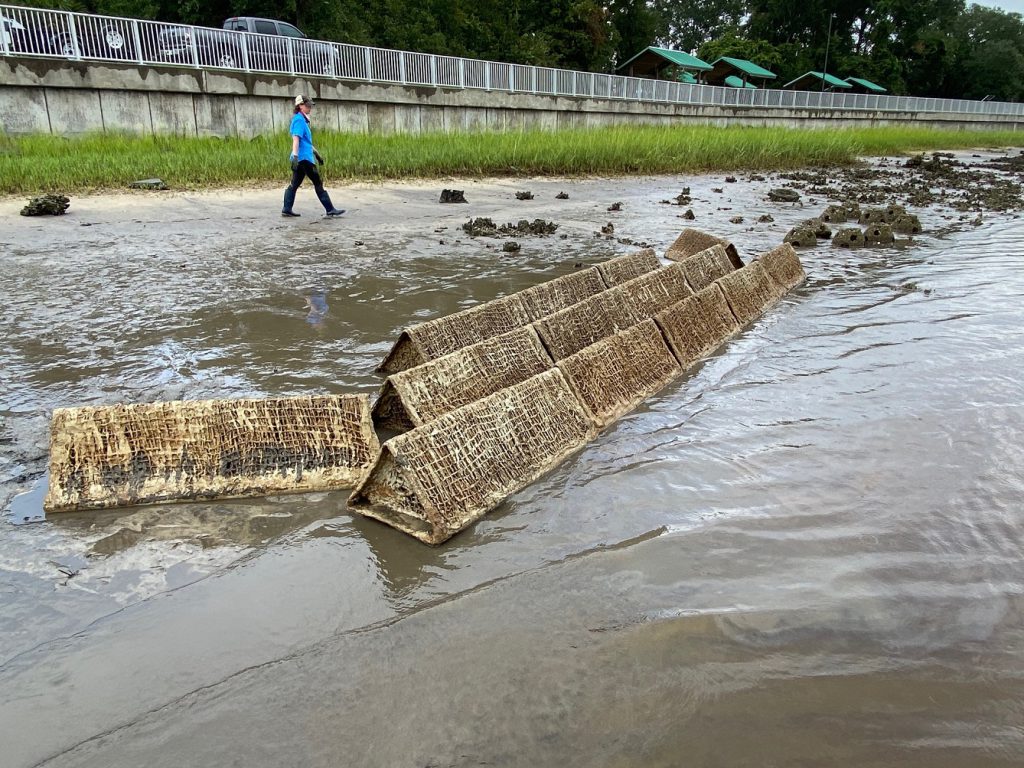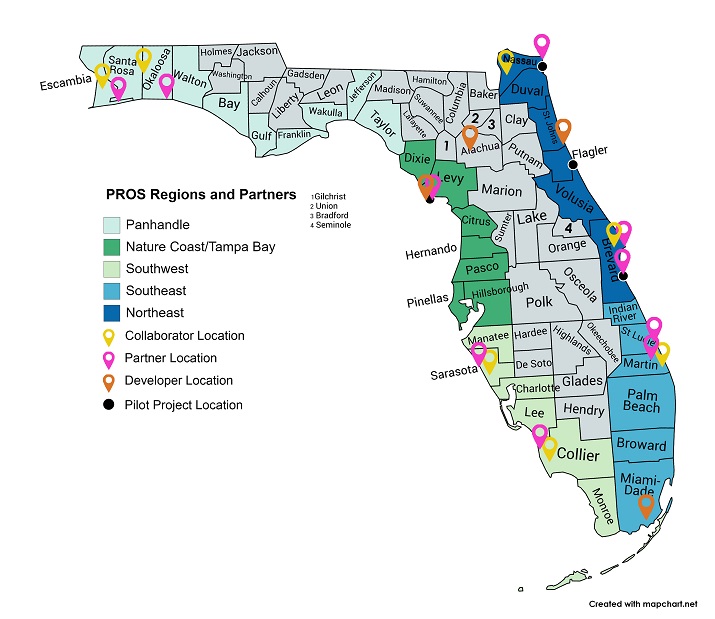We focus a lot on oyster restoration here at the Nature Coast Biological Station and a new project aimed at reducing plastic use in oyster restoration has us excited. This project is called the Partnership for Plastic-free Restoration of Oyster Shorelines, or PROS for short. This network of practitioners, educators, and local government partners will work toward implementing living shoreline projects using a newly developed plastic-free material called reef prisms. Before we dive into the PROS collaboration, let’s learn more about reef prisms.
The problem of plastic in living shorelines
Living shorelines (coastal erosion control using native vegetation and other natural elements) are increasing in popularity as practitioners and homeowners learn about their many benefits. However, it has become increasingly evident that one of the most common living shoreline approaches – creating reefs by stacking up rows of “shell bags” (oyster shell contained in plastic nylon mesh sacks) – is highly problematic for shoreline restoration applications. This is due to the likelihood that the plastic mesh releases harmful microplastics into the marine environment and the concern that wildlife could become entrapped or entangled, especially as bags break down or if the reef project fails to establish.

Shell bags are widely applied because they have many benefits:
- they are cheap to produce,
- they are easy to build and deploy using volunteer assistance,
- they offer a high degree of flexibility in project design (i.e., can stack in any configuration), and
- they have a history of proven success in many states.
Because of these many benefits and the relative lack of viable plastic-free alternatives that encompass these benefits, the living shorelines community has been slow to move away from shell bags and other plastic-based materials. Perhaps the desire to continue working with volunteers and communities to build living shorelines is an overarching reason why shell bags remain popular. But most practitioners at national conferences and meetings express a desire to eliminate plastics from living shorelines.
Practitioners searching for plastic-free alternatives to shell bags will likely encounter many proprietary options such as domes, blocks, panels, and other forms made from portland cement. Often, these options contain embedded oyster shells or various additives aimed at adjusting the pH (the highly basic pH of portland cement is thought to hinder the development of some biological communities). Newer companies entering the market offer substrates made from recycled vegetable starch or rope-like filaments embedded with portland cement and formed into various shapes. While these alternatives may work in many contexts, most of them do not retain the benefits of shell bags since they cannot be produced locally or by volunteers, can be hard to deploy using volunteer labor, usually cost more than shell bags, or are not readily available in all markets. Therefore, the shell bag still often prevails over these alternatives. Furthermore, many of these alternatives have their own environmental downsides, such as the high carbon footprint associated with portland cement and long-distance transport of heavy cement items from factory locations.
Building better oyster reefs with reef prisms

The development team at the University of Florida, led by Dr. Mark Clark, spearheaded the creation of reef prisms (left). As with most inventions, necessity for our own use played a role. We wanted a modular, plastic-free alternative to shell bags that we could also build and deploy ourselves (and with volunteers) using affordable and readily available materials. Thus, reef prisms were born! Reef prisms (and other shape varieties) are made from a combination of jute-fiber erosion control mat and a rapid setting, low-shrink grout available from local big box stores. The chemical formulation of this particular grout allows for roughly 7x higher break strength, 35-50% lower carbon footprint, a more neutral pH (8.5 vs. 12.1), and significantly faster setting time in comparison to portland cement. The lower carbon footprint results from lower energy inputs during the production of the cement material.
Reef prisms carry many of the same benefits of shell bags and are superior to bags in many ways. We believe reef prisms are a viable plastic-free alternative to shell bags that could gain traction quickly in the living shorelines community. A key point is that volunteers can easily be engaged in the construction and deployment reef prisms, retaining the educational value that comes with involving community members in shoreline restoration. Another key point is that reef prisms are a new material and, like any new product, need further testing and research before we can be sure they live up to expectations.
Partnerships and pilot projects to explore the future of reef prisms

As interest in reef prisms mounted, we at UF/IFAS Extension and Florida Sea Grant brought organizations across Florida (see left) together to form the PROS Community of Practice through a grant from the Florida Department of Environmental Protection. This group of living shoreline practitioners will work toward implementing living shoreline projects using reef prisms in different waterbodies. The reef prism development team is responsible for the overall project coordination and technology transfer as living shoreline sites are selected and planned. Local governments, non-profit organizations, and UF/IFAS Florida Sea Grant Extension Agents are responsible for identifying the demonstration site locations and strengthening partnerships. A major part of the new project is to host regional reef prism construction workshop events to train more people how to build reef prisms for restoration projects. The team produces educational products and shares information through regular PROS Community of Practice meetings.

The reef prism process and material are fully open-source and available for any organization to adopt and apply for free through joining the PROS CoP (email me for details about how to join). The development team will not profit in any way from sharing the reef prism construction process (there are no royalties or license fees are involved), which stands in contrast to many of the plastic-free alternatives available from for-profit companies. We look forward to sharing more about our progress as we work with this amazing group of people!

This blog was funded in part, through a grant agreement from the Florida Department of Environmental Protection, Florida Coastal Management Program, by a grant provided by the Office for Coastal Management under the Coastal Zone Management Act of 1972, as amended, National Oceanic and Atmospheric Administration Award No. NA20NOS4190109. The views, statements, findings, conclusions and recommendations expressed herein are those of the author and do not necessarily reflect the views of the State of Florida, NOAA or any of their subagencies.
 2
2
